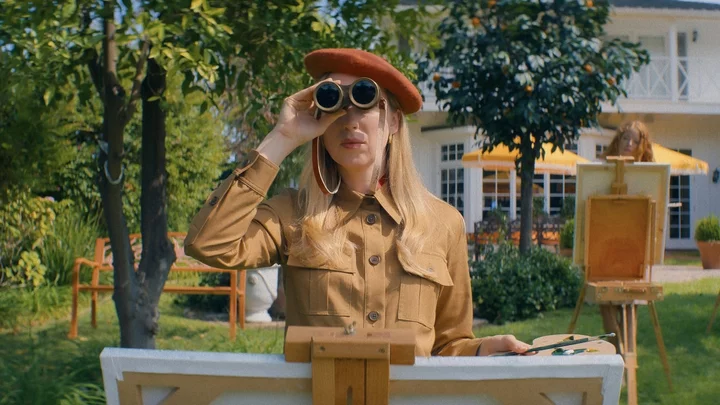
'The Afterparty's Wes Anderson episode is the perfect cure for lifeless AI parodies
If you've been on the internet at all since the rise of AI-generated art and
2023-08-03 17:59

'Zelda' searches skyrocket on Pornhub
The Legend of Zelda: Tears of the Kingdom has only been out for a few
2023-05-16 23:28

7 ways to ease back-to-school worries
School should be the best years of children’s lives – but, as the new term approaches, evidence suggests it’s actually the most worrying time for many kids. The children’s helpline Childline delivered 7,772 counselling sessions about school/education worries last year, with a big increase in calls in the run-up to the start of the new school year. “School is a huge part of a child’s life, so it’s important they feel happy and secure there,” says Childline director Shaun Friel. “We know some children can feel anxious and apprehensive about going back to school, particularly after spending a lot of time away from the classroom due to the summer break. “In fact, our Childline counsellors see a spike in the number of counselling sessions they deliver to children about school worries following the summer holiday season.” Friel says some children feel worried about making friends, getting lost, or the workload at a new school, while others may have concerns about returning to their current school due to friendship issues, fears about upcoming exams, or the recurrence of bullying. “However a child feels about returning to school, we want to remind them that these worries are normal and they aren’t alone,” he stresses. “If any child is feeling apprehensive about going back to school, our trained counsellors are here 24/7 over the phone and online.” As well as counselling, Friel says there are many things both parents and children can do to ease back-to-school anxieties. They include… 1. Writing feelings down Parents can get their child to write down everything they’re looking forward to at school, and everything they’re worried about. “Encourage them to show you the list so you can chat through their concerns, help them cope with their worries and also look at the positives,” suggests Friel. 2. Listening to their concerns If your child has concerns about going back to school, take time to listen to what they’re saying before you jump in to give advice or your opinion, Friel advises: “You could try repeating back what they’ve shared to check you’ve understood their feelings correctly – this will help them to feel really heard.” 3. Discussing practical solutions Once your child has shared any concerns or anxieties about going back to school, you could try talking through some practical solutions, suggest Friel. So, for example, if they’re worried about the amount of homework they’ll have, you could discuss how to break this down each evening and what they could do if they start to feel overwhelmed, like talking to their teacher or you. “You could start by asking them what they think might help them feel better about the situations that worry them,” says Friel. “This can encourage them to learn to think for themselves and feel in more control of the situation.” 4. Reminding them to take their time Remind your child it can take time to adjust to being back at school, and it’s okay if it doesn’t feel comfortable at first, says Friel. “Being back at school will mean a totally different routine, and it’s important to remember that this can take some getting used to,” he stresses. 5. Doing things they enjoy When kids are back at school, making time every day to do something they enjoy can really help to ease anxiety, says Friel. “Whether it’s time in their evening with friends, reading a book or hanging out with their siblings, it’s important to take time out,” he advises. 6. Talking to a trusted adult It’s important children are aware they can and should talk to a safe adult – perhaps a parent, carer, teacher, sibling over the age of 18 or a Childline counsellor – about anything. “No matter what the reason, if a young person is struggling ahead of going back to school, it’s vital they’re encouraged to talk to a safe adult about it,” stresses Friel. “Sharing their feelings with someone they trust will help them feel less alone with their worries, and that adult will be able to support them with this moving forward.” 7. Distracting themselves If children or young people make an effort to keep busy doing something they enjoy, such as playing football or listening to music, this could distract them from their worries, at least for a little while, says Friel. Staying connected with friends and family, whether that be online or in person, or doing some physical activity like going for a walk or taking part in a sport, can also be a good distraction technique. Young people can contact Childline, which is run by the NSPCC and supported by the People’s Postcode Lottery, on 0800 1111 or via 1-2-1 chat on Childline.org.uk Read More Charity boss speaks out over ‘traumatic’ encounter with royal aide Ukraine war’s heaviest fight rages in east - follow live What is the best type of facial for your age range? King Charles reshuffles military roles with new duties for William and Kate Government urged to remove VAT from period pants
2023-08-11 15:46

The dish that defines me: Michele Pascarella’s Neapolitan ragu
Defining Dishes is an IndyEats column that explores the significance of food at key moments in our lives. From recipes that have been passed down for generations, to flavours that hold a special place in our hearts, food shapes every part of our lives in ways we might not have ever imagined. I was very young when I started working in a local pizzeria in Caserta, the city near Naples where I grew up. I was 11 years old when I started working there, and stayed on for about eight years before moving to London to start my own business. But during my teenage years, one of the best memories I have is waking up to the smell of my mother’s ragu on Sundays. Neapolitan ragu is a specialty in the region, and we are very proud of it. It’s one of the two most famous varieties of ragu, the other being ragu bolognese, and uses whole chunks of beef and pork rather than ground meat. It must be cooked for a long time over a low heat, for at least eight hours, preferably 10 hours. My mother would get up at 5am to start making hers and it would continue to simmer slowly until the family is ready to eat in the afternoon. Sundays are special because it’s a time for the whole family, including our extended family, to come together and eat at the same table. My family comprised of my parents, my three siblings and myself, and we would usually be joined by my grandparents, aunts, uncles, cousins. We usually had anywhere between 15 to 20 people gathering on Sunday afternoons. It didn’t matter what commitments you had – on Sunday, you have to sit at the table with family. It’s the most important day of the week for us. The ragu is the dish that, for me, brings everything together: passion, love, happiness and strong ties with family. Because I worked late shifts often, I would wake up really late on Sundays, around 11am or 12pm. So by the time I wake up, the beautiful aroma of the ragu that has been cooking since 5am will have filled the whole house. I would wake up so hungry. My breakfast on these days would simply be a hunk of bread, torn and dipped straight into the still-simmering sauce, with some parmigiano reggiano sprinkled on top to help cool it down. Every family has their own way of eating ragu. You can dip bread in it, like I did for breakfast, but it is most commonly eaten with pasta. Some people have it with gnocchi while others might use a short pasta or spaghetti. But it does have to be a robust pasta shape, you can’t have ragu with a really small pasta, or it won’t stand up to the sauce. No one makes ragu like my mother’s. I could go to any restaurant, even those with Michelin stars, and it wouldn’t come anywhere close to hers. I strongly believe her secret ingredient is just her love for cooking for her children, as the dish needs that passion to make it taste so good. I never woke up at 5am to try and make it with her, it was so hard when I was a teenager! But when I did start to learn how to make it, it was very difficult to get up that early. I don’t know how she did it for so many years. In my restaurant, Napoli on the Road, I make a pizza with the slow-cooked ragu as a topping, along with a parmigiano reggiano cream. I call it Ricordi D’infanzia, which translates to “childhood memories” because it holds such strong nostalgia for me. But I still can’t make it like my mother does. When I go home to Caserta to see my family, I do try to wake up at 5am to make it with her. I’m less stressed about work when I’m there so I can usually do it, but when I’m back in London it’s hard to get up at that hour when you finish at midnight at the restaurant. Like most mothers who pass down their recipes, there are no accurate measurements to my mother’s ragu. Sometimes they put some sort of secret ingredient inside and won’t tell you. But I have learnt that you need to be flexible about it, depending on what ingredients are available to you. For example, maybe the tomatoes you buy from the market are too acidic. My mother fixes this by putting a whole potato in the sauce, because its starchiness will help to remove the acidity from the tomatoes. Or, she might add sugar to the sauce to mellow it out. It can be tricky to get it right, so I can only try my best to do better than my mother, but it is hard. I think I will be 80 or 90 years old before I perfect my own version! I’ve lived in London for almost 20 years, but I still miss those Sunday afternoons spent with my family at my uncle’s or grandfather’s house. In London, things are very fast-paced and rushed, you don’t really have time to sit down with people. I try to go back every couple of months, and I really look forward to it. My mother still makes her ragu. Even though nowadays it’s harder to get everyone together, we do our best to keep everyone united. I don’t have any family in London, so it’s important to me to keep that tradition alive when I go home. My dad has never visited me here because he is afraid of flying, but my mother comes fairly often and I’ll make ragu for her when she does. She never says anything bad about it – although, she will tell people: “It’s good… but it can be improved.” Still, I’m glad I have the opportunity to make it for her sometimes and it keeps me connected to home. Michele Pascarella is the chef-owner of Napoli on the Road. Read More The dish that defines me: Evelin Eros’s rum cake The dish that defines me: Mallini Kannan’s baked honey-soy salmon The dish that defines me: Frank Yeung’s prawn wontons
2023-09-12 13:46

Drag queen Ella Vaday plans on ‘bringing camp to the campsite’ in 100km trek
RuPaul’s Drag Race star and actor Nick Collier, who performs as Dagenham drag queen Ella Vaday, is embarking on a 100km trek with CoppaFeel! alongside celebs including Frankie Bridge and Giovanna Fletcher. The 100km trek is raising funds for breast cancer support, and as his mother has been suffering from breast cancer since 2021, Collier is eager to do his bit.The Drag Race runner-up is really close to his mum. “I am the eldest of three, and me and my mum are very similar in many ways. I left home at 16 to train in dance and musical theatre, but I am always looking out for my mum.” “She has had breast cancer since 2021. She’s actually just finished her treatment and she is nearly there with injections,” he explains. The opportunity to take on this adventure and raise some funds “came at a really great time,” for Collier. “It’s nice to celebrate my mum, as she has had cancer for a second time. This is my way of giving back, celebrating her journey and also putting myself to the test and raising some money.” Many may be thinking the hardest part of this trek would be the actual walking, but as a former dog walker and fitness fanatic, Collier isn’t worried about the fitness aspect, instead, his concerns are “the weather and… sleeping in a tent. I am not looking forward to that, but I am bringing the camp to the campsite,” he jokes. This year, he has taken some time to really focus on his fitness and wellbeing, and is “in the gym five days a week,” improving his strength and stamina as a performer. Since he trained as a performer at Bird College, he has been keen to look and feel good. Collier has faced the physical demands of Drag Race and taken on that challenge, reaching the final. And, with hindsight, he sees just how intense and physical that challenge was. In the competition, he flawlessly impersonated much-loved British culinary sensation Nigella Lawson, performed showstopping live vocals and even dressed up as a striking Dagenham Ford worker. “It was so full on, so intense. You don’t see half of what goes on, with the early mornings and long days, the lack of connection to the normal world. There are elements of mental and physical fatigue,” Collier shares. “It was the best experience ever and I feel like the trek will be similar.” But, ahead of the finale, disaster struck Collier as he sustained an injury to his back. “I was injured for the finale and the morning of the finale I couldn’t even put my socks on, but I had no choice but to get through filming. “That was a moment I had to fight through, to be able to get home to see my partner, Marco, and my family.” Having performed on the West End for several years in shows including The Book Of Mormon and Wicked, while also running his dog-walking business, Collier is no stranger to hard work. His resilience and ability to push through tough times is a trait Collier is proud of, one that will support him in his trek and one that he believes he has really acquired as an LGBTQ+ person. “We have always been faced with obstacles, the first being having to come out, which really sucks,” he explains. “The fact I have to tell people what my sexuality is, is an obstacle. Discovering your identity when you are put in a box, is an obstacle to overcome.” He has also found that despite the acceptance of LGBTQ+ people in the entertainment industry, “in the acting world, as an outwardly gay person, it is hard to get chosen for straight roles and it is really frustrating sometimes,” he explains. This June, Nick Collier will be completing the ‘CoppaTrek! with Gi’ in Hadrian’s Wall Country alongside Giovanna Fletcher, to raise vital funds and awareness for breast cancer charity, CoppaFeel! To donate, please visit coppafeel.org/give. Read More Charity boss speaks out over ‘traumatic’ encounter with royal aide Ukraine war’s heaviest fight rages in east - follow live A beginner’s guide to topiary Irish premier Leo Varadkar’s partner apologises for ‘poor judgement’ coronation posts 9 actually useful things you can do to support teens this exam season
2023-05-16 15:52

How to Save the Most Money on Prime Day
We're halfway through the year, so that means Amazon Prime Day is upon us once
2023-07-11 05:26

The chef who hated food as a child
Jeremy Pang doesn’t have a classic chef origin story: he “hated” food as a child. Before he turned 10, the chef, teacher and owner of the School of Wok in London admits: “I hated eating – I honestly did not like food. “Up to the age of, like, nine, it would take my mum two, three hours to get my dinner down me. I just didn’t want to eat – I wanted to go out and play football with my mates. I wanted to go and do stuff and play – I also wanted to eat fish fingers and all the stuff my friends were eating at home.” Pang grew up in a Chinese household and is a third-generation chef. When he was 10 years old, his family moved from the UK to Singapore for two years. Now aged 39 and based in southwest London, Pang says upon making the move, his “life completely changed”. He says: “When you go into hawker centres [open-air food markets] in Singapore, it’s a different world. Every single stall is a specialist in one type of food – not even cuisine. So you might have one uncle who has cooked chicken rice for his whole life, or another person who has cooked Hokkien Mee [a stir-fried noodle dish] for 40 years. “When people are as specialist as that, you cannot not want to eat it. And you see everyone digging into their food with no real etiquette – but the etiquette is the enjoyment of that bowl of food.” From there, Pang says Singapore “opened mine and my sister’s horizons” and he fell in love with food. With Singapore’s proximity to other Southeast Asian countries, he was exposed to a variety of cuisines – from Indonesian to Malaysian – many of which are taught at the School of Wok, along with the Chinese food Pang grew up with. With two kids of his own, aged six and two, Pang says: “I now feel so sorry for my mum.” Before the Covid-19 pandemic, the chef says of his oldest: “It was really difficult to get him to enjoy anything that wasn’t raw carrot or cucumber – which actually is healthy at least, but every day? That’s hard.” The pandemic shifted his son’s eating habits. Pang took a couple of months off and “cooked with him – we started making homemade pizzas, flapjacks – anything he wanted to make. He definitely at that point thought he had more of a Western palate, but I’ve known since he was really young and started eating that he does love Chinese food. “He likes the slightly lighter palate, and home-cooked Chinese food can be quite light – steamed fish, flash-fried vegetables, things like that.” One constant from Pang’s childhood to his family life now is the concept of feasting – serving multiple dishes for one meal. “This is how Asian cuisine is eaten, and should be eaten,” he says simply. “My style of cooking is 100 per cent home cooking anyway, and I’ve grown up with it. If you are Asian, that’s just a way of life. But if you’re not, it’s hard to compute how to get four or five dishes on the table, all hot or in the right state at the right time.” He continues: “Even if when we’re doing midweek meals at home, if I’m cooking Chinese or Southeast Asian just for the four of us, I’ll quite often cook two or three dishes. Those two or three dishes are there to be shared – that absolutely is our way of cooking and eating.” Pang’s latest book, Simple Family Feasts, is all about demystifying this concept for home cooks who haven’t grown up with it. Each chapter is dedicated to a different cuisine – including Chinese, Vietnamese, Singaporean and Indonesian – and shows you how to build a feast, guiding you through which dishes to make and in what order. Balance is crucial to pulling off a feast. “If, for example, you just ate crispy, deep-fried stuff – which is terribly bad for you, but we all love it – yes, you want to eat lots of it at the beginning. But five minutes later, you might get lost in that deep fried, crispy, greasy world, and so you’re likely to stop eating it at some point quite quickly. “But if you had something crispy, you have something opposite that melts in the mouth, you had something soft with a gentle bite, you had crunchy – usually from fresh vegetables or flash-fried vegetables, salads, anything like that – and you had a perfect balance of those textures. Honestly, I think you could just keep eating.” Growing up with this style of cooking must make Pang a brilliant multitasker – something he says is “a great skill to have”, but “sometimes it’s my worst enemy”. “I’m constantly multitasking – I get to the end of the day and I don’t know what’s happened, I sometimes can’t tell you what I’ve done in a day. I might have done a million different things… So in some ways, I’m very good at multitasking – but when I get home, my wife probably wouldn’t agree with that.” Like all of Pang’s cookbooks, this is an “ode to my father”, who passed away in 2009. “He’s the one who instilled that love of cooking and cuisine – especially Asian food. He never really taught me how to cook, he just said, ‘Stand and watch’, or, ‘Taste this and tell me what’s in it’. That was his style of teaching.” ‘Jeremy Pang’s School Of Wok: Simple Family Feasts’ (published by Hamlyn; £22). Read More Marina O’Loughlin is wrong – there’s joy in solo dining Budget Bites: Three recipes to keep food bills down before pay day Meal plan: Romesco chicken and other recipes to fall in love with Who knew a simple flan could be so well-travelled? Midweek comfort food: Singaporean curry sauce and rice How to make Thai favourite lemongrass chicken stir-fry
2023-08-09 13:46

These 9 Celebrity Sex Toy Lines Make My Vagina Feel Famous
We live in a time where information about our favorite celebrities is readily available — the clothes they wear, their skin-care regimens, workout routines, the recipes they use, where they vacation, and so much more. So, it’s only natural that we’d be curious about their sex toy preferences. After all, sexual pleasure is a purchase we can all stand behind, and female celebrities have long been at the forefront of erasing the lonely girl stigma that formerly surrounded purchasing vibrators — because putting your own pleasure first should never be stigmatized.
2023-09-22 04:48

Inside The Anti-High Fashion Show Making Puerto Rico’s Style Scene More Inclusive
The sun almost set in Caguas, a town in Central Puerto Rico, when the second annual Paseo Pasarela, a fashion show highlighting local designers, began. But while a typical runway would involve seating assignments, sponsored goodie bags, and elaborate venues, the setting for this fashion show is more representative of the aftermath of a decades-long financial crisis and consecutive natural disasters in Puerto Rico: A makeshift runway in the center of town’s plaza, surrounded by permanently closed storefronts (like El Telar, the textile shop my mom and I used to visit every Saturday when I was growing) and abandoned buildings — relics of a once-booming town.
2023-07-19 00:25

Alix Earle has fans in splits with hilarious ‘Before & After’ video of hairdo for New York Fashion Week
Alix Earle wowed at Dion Lee's NYFW show with bangs and long extensions as she later humorously shared her transformation on Instagram and TikTok
2023-09-14 17:51

Get an iPad Mini (6th gen) for $99 off with this late Prime Day 2 deal
SAVE $99: The Apple iPad Mini (6th gen) is on sale for $399.99 now, which
2023-10-13 01:47

The Best Computer Monitor Deals for August 2023: LG, Asus, Dell, More
Amazon Prime Day, like the one in July, always prompts device purchases of all kinds:
2023-08-02 04:59
You Might Like...

Mozilla Is Adding a Fake Review Checker to Firefox

‘Final Fantasy’ Maker’s 30% Plunge May Be Just the Beginning

Video shows hero Irvine PD cops saving adorable puppy from fentanyl overdose

'Wilderness' trailer teases tense thriller about a woman plotting her husband's murder

Rumer Willis reveals her daughter’s name was inspired by typo in a text

Upgrade your smart home with an Amazon Echo Show 8 and color bulb for under $70

Barbie Is This Generation’s Feminist Movie

Chinese livestreamers set their sights on TikTok sales to shoppers in the US and Europe
